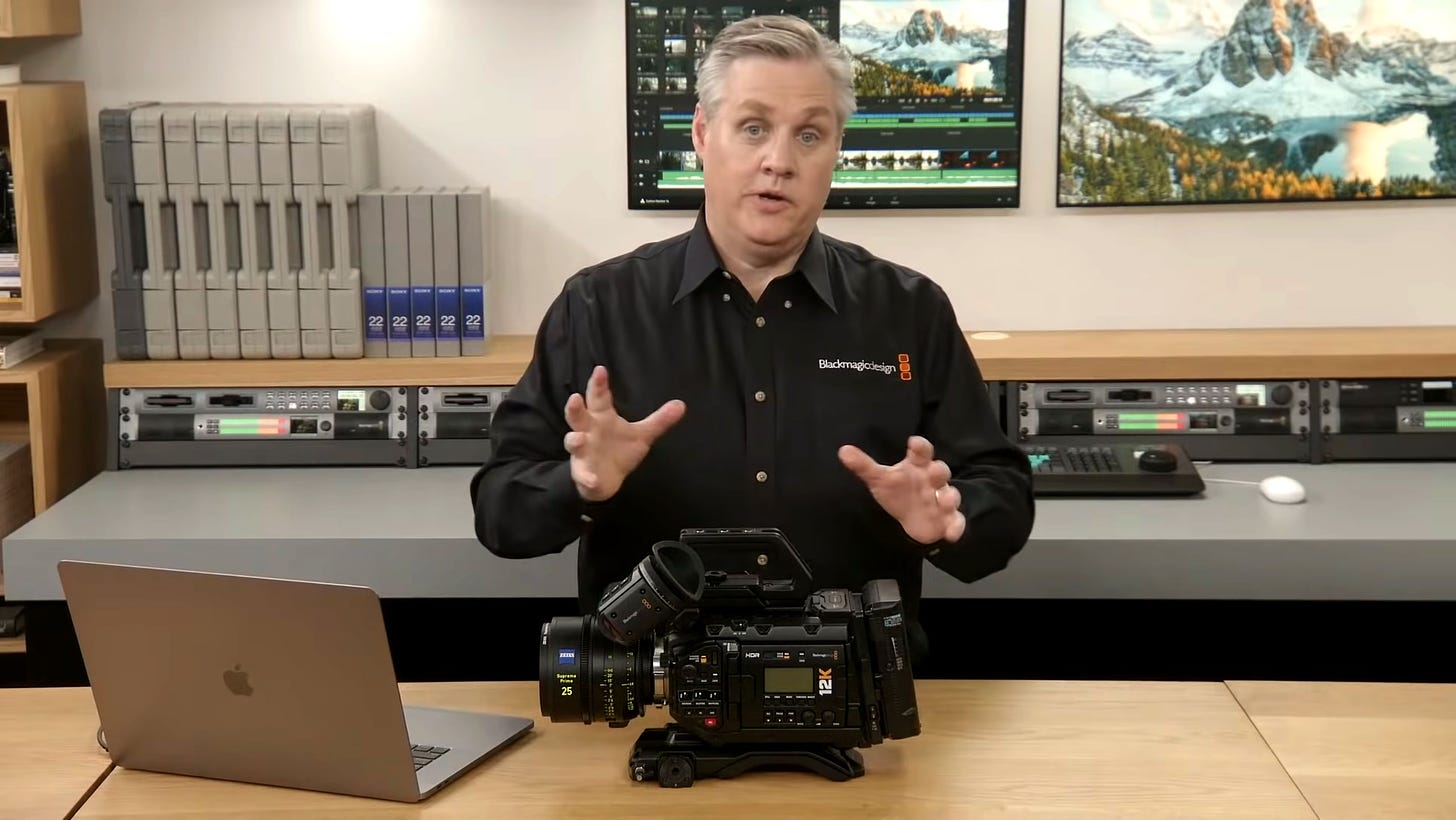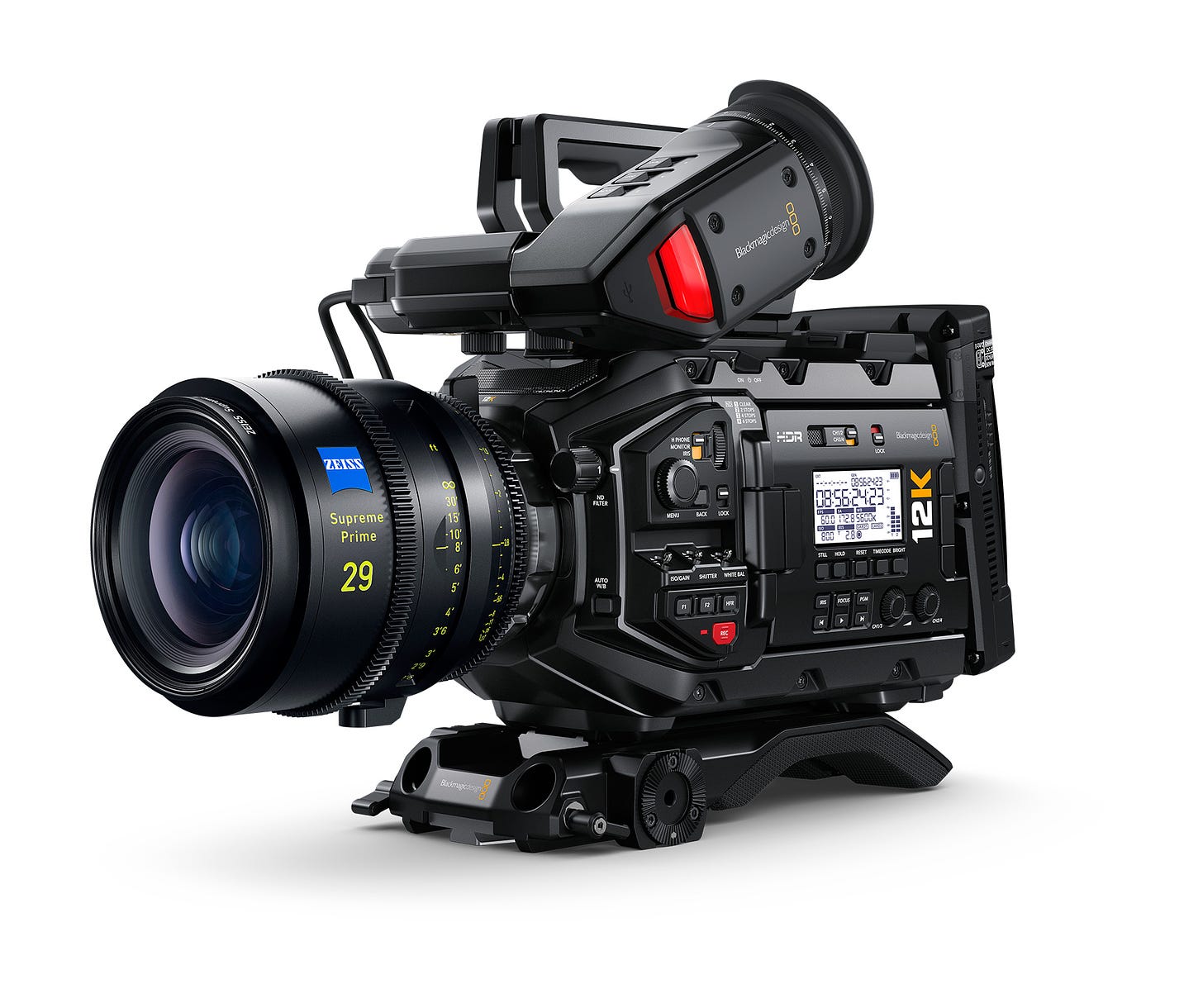Blackmagic’s 12K Ursa Mini Pro Shoots Beautiful 4K, Too. Here’s Why. (Also: Netflix Starts Shooting in L.A. Again)
Pro Studio News: July 17, 2020
Blackmagic Design Debuts Ursa Mini Pro 12K for $9,995
Well, that was some announcement.
Blackmagic Design said it will ship the Blackmagic Ursa Mini Pro 12K this month. That’s right: 12K. (Presumably they heard that Spinal Tap’s only goes to 11.)
In this case, that means 12,288 x 6,480 pixels. As yet, there is no “12K” in the UHDTV standard. Just as impressive as the camera’s sheer resolution is its frame rate — not only does the Ursa Mini Pro 12K record 80 megapixels per frame, it does it at up to 60 frames per second.
The Ursa Mini Pro 12K brings with it a new generation of color science optimized for the Blackmagic Raw codec, with a new film curve, and instead of the standard Bayer filter, it has a new type of “symmetrical” color filter that Blackmagic Design CEO Grant Petty said makes scaling the image to lower resolutions a piece of cake. (Read more about that below; scroll to “Breaking the Bayer Pattern.”) It’s part of Blackmagic’s attempt to make inroads in high-end feature film, VFX and TV commercial workflow.

This sensor is designed specifically for high-end film.
— Grant Petty, CEO, Blackmagic Design
“This design started back when we were originally working on Blackmagic Raw,” Petty said during a livestream introducing the camera. “There’s a lot of research going into this—a lot of new technology for the highest-end work. We’ve been focusing on going beyond what we’ve previously been doing in any of our cameras, and we’ve got a whole bunch of patents on the way.”
The Ursa Mini Pro 12K ships with a PL mount, but the lens mount is interchangeable and will support EF and F mount lenses, too. The sensor has a Super 35 form factor, measuring 27.0336mm by 14.256mm with a 30.56mm image circle, and native ISO 800. Petty said it should work with all Super 35 and APS-C lenses and supports Cooke Optics’ /i technology for recording lens data.
The camera has built-in ND filtering, dual Cfast card slots, and a USB Type-C port on the back for connecting a drive such as the new Blackmagic URSA Mini Recorder ($395), which supports NVMe SSDs. It can be monitored in UHD via 12G-SDI output. Also included is a license for DaVinci Resolve Studio.

Blackmagic URSA Mini Pro 12K Features
12,288 x 6480 12K Super 35 sensor.
Use for feature films, VFX and high end TVC's.
14 stops of dynamic range and native 800 ISO.
New Blackmagic RAW for real time 12K editing.
Blackmagic RAW optimized for Metal, CUDA and OpenCL.
Generation 5 Color Science with new film curve.
Shoot up to 60 fps in 12K, 110 fps at 8K and 220 fps at 4K.
Dual card CFast recording at up to 900MB/s.
PL mount included, EF and F mounts available.
SuperSpeed USB-C for recording to external disks.
Includes DaVinci Resolve Studio for post production.
Compatible with new Blackmagic URSA Mini Recorder.
But Who Needs It?
Who needs 12K? Well, almost nobody, honestly. But it can be helpful. Footage destined for oversized installations or large-format exhibition (think stadium signage or big Imax screens) can use the extra pixels. A “supersampled” image generally looks better even when it’s downscaled to a lower resolution, so 12K images may seem to have just that little bit more detail, even on a show that’s delivered in HD or 4K. And VFX artists love super-high-resolution plates, especially when it comes to green-screen footage, because it makes some compositing tasks easier.
But the camera does some nice tricks at lower resolution, too. Shooting at 8K tops out at an impressive 110fps, and you can shoot 6K and 4K using a Super 16 sensor crop at up to 220fps.
Blackmagic uploaded new Mac OS X-only beta versions of DaVinci Resolve and Resolve Studio that support the Ursa Mini Pro 12K to its website, along with a public beta of its Blackmagic Raw 2.0 software.
Breaking the Bayer Pattern
Blackmagic says the camera, the third-generation Ursa Mini Pro, features a new, Blackmagic-designed sensor that captures up to 14 stops of dynamic range and has “equal amounts of red, green and blue pixels.” What does that mean? Well, it’s important for color resolution. The photosites on a digital sensor really only measure the amount of light—the number of photons—hitting them, not the color of that light. Traditional three-CCD broadcast cameras use three separate sensors built around a prism that filters light into separate beams of red, green and blue light that are captured across the full raster of the three separate sensors. Those images are then combined and processed to generate a full-color image.
Most single-chip image sensors utilize a color filter array known as a Bayer filter to control the color—red, green or blue—hitting each photosite. The Bayer filter, patented in 1976 by Bryce Bayer, arranges red, blue and green filters in a pattern utilizing twice as many green elements as red or blue, an attempt to capitalize on the physiology of human eyes, which are especially sensitive to green light. The sensor captures what’s called a Bayer-pattern image that must be “demosaiced” using data from surrounding photosites to determine the color values of each individual pixel and create an image with interpolated full color.
Blackmagic is bucking the Bayer filter by using a “symmetrical” color-filter pattern with equal numbers of red, green and blue pixels. This allows the image to be scaled in the sensor, meaning users can switch easily between resolutions without cropping the active image area on the sensor—and delivering full-raster color when recording 4K images. Grant Petty said getting those higher quality images at lower, more practical resolutions was the real impetus behind designing a new 8K sensor.
“Bayer sensors were designed originally for consumer cameras,” Petty said during the product launch. “You can get very good pictures out of Bayer sensors, but we’ve been focusing on the extreme high end. This sensor is designed specifically for high-end film.”
Accordingly, Petty said the camera is shipping to “high-end DPs” first, because the company wants to get feedback on its applicability in those high-end workflows. General shipment will begin “in a couple week’s time,” he said.
For more information: Blackmagic Design Ursa Mini Pro
Netflix Promotes Ted Sarandos to Co-CEO, Resumes Shooting in L.A.
Netflix promoted its head of content, Ted Sarandos, to a new co-CEO position alongside top exec Reed Hastings. Sarandos will remain in his position as chief content officer. The news came as Netflix recorded a record gain of 10.1 million paid memberships in the quarter ending June 30. (Compare that to a gain of 2.7 million in the same period last year.) But the company acknowledged that growth is slowing again following “the initial shock” of the Covid-19 crisis.
Speaking of Covid-19, Netflix said it is slowly ramping up production worldwide, noting Korea as an example of a country where it never completely shut down work. Production has resumed in countries including Germany, France, Spain, Poland, Italy and the U.K. as well as the United States, where the company said it has two films in production in California and two stop-motion animation projects underway in Oregon.
“Even during the shutdown, we were partially shot on a lot of shows, so when we pick them back up it’s not like starting from scratch again,” Sarandos said. “Outside of North America and parts of India and Brazil, we’re running pretty much in a normal fashion in terms of our volume around the world. It’s ramping up in various stages of pre-production and we’ve got a couple of shooting days in Los Angeles this week that we’re really excited about.”


